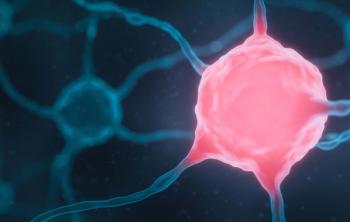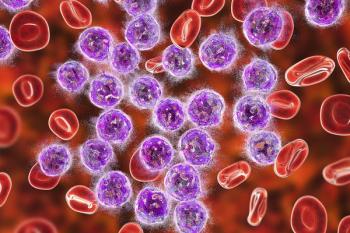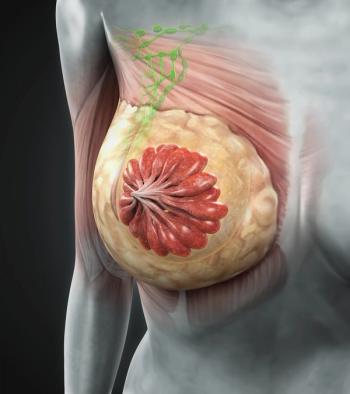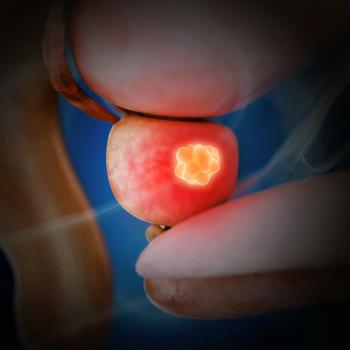
Addition of Daratumumab to RVs Improves Responses in Transplant-Eligible Patients with Newly Diagnosed MM
Daratumumab plus lenalidomide, bortezomib, and dexamethasone improved response rates and depth of response in patients with transplant-eligible, newly diagnosed multiple myeloma.
The addition of daratumumab (Darzalex) to lenalidomide, bortezomib, and dexamethasone (D-RVd) followed by daratumumab and lenalidomide (D-R) maintenance showed a statistically significant improvement in response rates and depth of responses in patients with transplant-eligible newly diagnosed multiple myeloma, according to data presented at the 2020 American Society of Hematology (ASH) Annual Meeting.
The updated analysis of the GRIFFEN study showcased that D-R maintenance therapy improved the depth of response for patients while maintaining remissions.
“As noted, these results support D-RVd as a potential new standard of care for transplant eligible newly diagnosed multiple myeloma patients,” Jonathan L. Kaufman, MD, Winship Cancer Institute, Emory University, said in his presentation of the data.
The researchers found in earlier data cuts that the responses from patients to these treatments deepened over time, with response rates and depths greater for patients in the D-RVd arm at all points in time. At the end of consolidation, the stringent complete response (sCR) rate was 42.4% in the D-RVd arm (n = 104) compared to 32% in the RVd arm alone (n = 103; P < .0014).
For the data regarding the 12 months of maintenance cutoff, the sCR rate was 63.6% versus 47,4% for the D-RVd arm and RVd alone arm, respectively.
Researchers also examined minimal residual disease (MRD)-negativity after 12 months of maintenance therapy, finding that, in an intent to treat manner, the total MRD-negative rate in the D-RVd arm was 62.5% compared to 27.2% for the RVd alone arm (P < .0001). Solely examining the MRD evaluable group of patients, the MRD-negativity rate was 78.3% for the D-RVd arm (n = 83) versus 39.4% for the RVd alone arm (n = 71; P < .0001).
More, durability of MRD-negativity at both 6 and 12 months was significantly higher in the D-RVd arm versus the RVd alone arm. For 6 months, the MRD-negative rate was 37.5% in the D-RVd arm, compared to only 7.8% in the RVd alone arm (P < .0001). At 12 months, the rates for the D-RVd and RVd alone arms were 28.8% and 2.9%, respectively (P < .0001). The data showed a significant improvement in the rates of sustained MRD-negativity for the D-RVd arm versus RVd alone.
From an MRD-negativity standpoint, there is not a subgroup of patients that does not benefit from adding DARA to RVd treatment.
“D-RVd is now considered a treatment that is appropriate for (the National Comprehensive Cancer Network). I know that we have made this our standard of care at our center,” explained Kaufman “It is a regimen that is well tolerated, its effective, it doesn’t negatively impact the ability to collect stem cells or patients to engraft after stem cell transplant. The goal of our induction therapy is to induce MRD-negatively and what we see here is that this regimen is very good at reducing MRD-negativity.”
The primary end point of the study was sCR, with secondary end points including MRD-negativity rates and overall response rates (ORR).
The researchers also explained that there is currently no statistical difference between progression-free or overall survival in both arms, with a median follow-up of 27.4 months.
While there was a noticeable increase in rates of neutropenia and upper respiratory infections for the D-RVd group compared to RVd alone, these increased rates did not lead to higher rates of discontinuation for patients. More, similar rates of any grade and grade3/4 infections were observed for D-RVd versus RVd.
Looking ahead, there is an ongoing phase 3 PERSEUS study that is evaluating subcutaneous D-RVd in the transplant-eligible population of patients with newly diagnosed multiple myeloma.
Reference:
Kaufman JL, Laubach J, Sborov DW, et al. Daratumumab (DARA) Plus Lenalidomide, Bortezomib, and Dexamethasone (RVd) in Patients with Transplant-Eligible Newly Diagnosed Multiple Myeloma (NDMM): Updated Analysis of Griffin after 12 Months of Maintenance Therapy. Presented at: 2020 ASH Annual Meeting and Exposition; December 5-8, 2020; Virtual. Abstract 549.
Newsletter
Stay up to date on recent advances in the multidisciplinary approach to cancer.
























































































